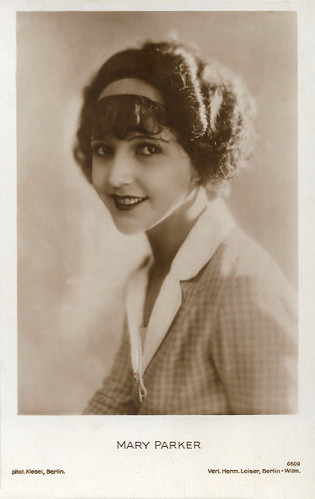
German postcard by Verlag Herm. Leiser, Berlin-Wilm., no. 6509. Phot: Kiesel, Berlin.

German postcard by Ross Verlag, Berlin, no. 956-1, 1925-1926. Photo: Richard Oswald-Film AG, Berlin.
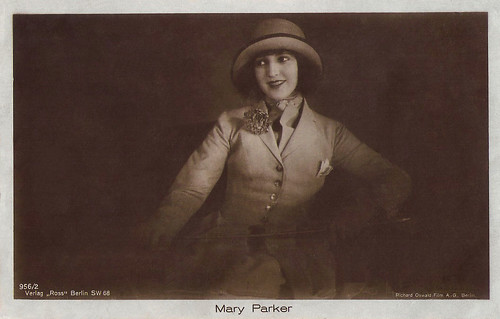
German postcard by Ross Verlag, Berlin, no. 956/2, 1925-1926. Photo: Richard Oswald-Film, Berlin.
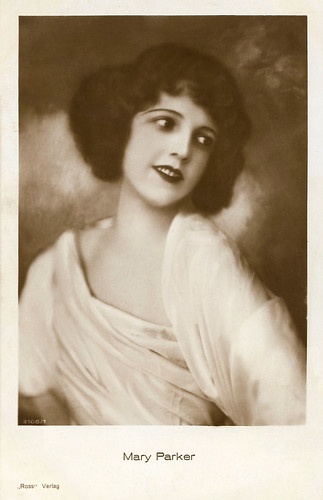
German postcard by Ross Verlag, Berlin, no. 3108/1, 1928-1929.
Sex education film about venereal disease
Mary Parker was born Magdalena Prohaska in Breslau (today Wroclaw), Poland, in 1902.
She debuted in German cinema in Die schönste Frau der Welt/The most beautiful woman in the world (Richard Eichberg, 1924) starring Lee Parry. Quickly several other films followed, such as the comedy Lumpen und Seide/Rags and silk (Richard Oswald, 1924), in which the rich Irene (Mary Parker) tries to refresh her marriage with Erik (Johannes Riemann) by taking a girl from the slums, Hilda, (Mary Kid) into their home. Hilda has a fiancee, Max, who is a shameless profiteer (Reinhold Schünzel).
Other memorable titles are Die Schmetterlingsschlacht/The Butterfly Battle (Franz Eckstein, 1924) starring Asta Nielsen, the Swiss production Das Paradies Europas. Bild vom Schweizer Volk und seinen Bergen/The Paradise of Europe. Image of the Swiss people and their mountains (Walther Zürn, 1924-1925), and Zaungäste des Lebens/Onlookers of life (Nikolai Malikoff, 1925) with Angelo Ferrari.
In Halbseide/Half silk (Richard Oswald, 1925), Parker had the female lead opposite Bernd Aldor as her husband. She also had a major part in the comedy Vorderhaus und Hinterhaus/Front house and back house (Richard Oswald, Carl Wilhelm, 1925) about a widower (Max Adalbert) who sublets a part of his house to the girl of his dreams (Parker) and her family.
For director Richard Oswald, Mary Parker also appeared in the sex education film Dürfen wir schweigen/Should We Be Silent? (Richard Oswald, 1926) about a painter (Conrad Veidt) who refuses to be treated for his venereal disease.
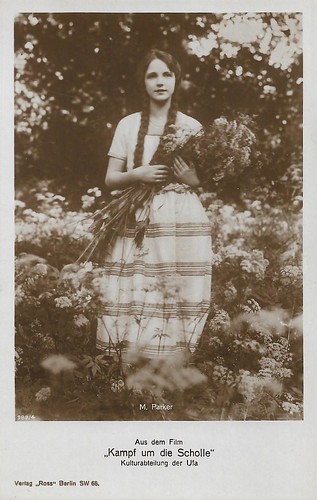
German postcard by Ross Verlag, no. 989/4, 1925-1926. Photo: Kulturabteilung der UFA. Mary Parker as Luise, daughter of the estate manager Karl Marten in Kampf um die Scholle/Struggle for the Soil (Erich Waschneck, 1925).
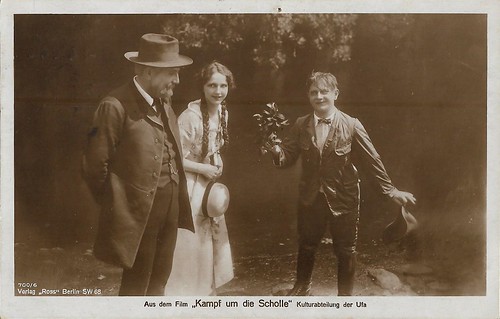
German postcard by Ross Verlag, no. 700/6. Photo: Ufa. Publicity still for Kampf um die Scholle/Struggle for the Soil (Erich Waschneck, 1925) with Otto Kronburger as Karl Merten, Mary Parker as his daughter Luise, and Hans Hermann (Schaufuss) as Gutseleve Fritz Quirlitz.

German postcard by Ross Verlag, no. 700/9. Photo: Ufa. Publicity still for Kampf um die Scholle/Struggle for the Soil (Erich Waschneck, 1925) with Oscar Marion as Franz, the younger brother of estate owner Axel, who has an affair with Luise (Mary Parker), daughter of the estate manager Karl Marten (left; Otto Kronburger). The man behind Parker is Wilhelm Diegelmann, who plays Uncle Uhl.
Just a few performances in German sound films
In the following years, Mary Parker also played in films like Ich hab mein Herz in Heidelberg verloren/I lost my heart in Heidelberg (Arthur Bergen, 1926), Das süsse Mädel/Das süße Mädel (Manfred Noa, 1926), the Danish film Dydsdragonen/The Dragon of Virtue (Valdemar Andersen, 1927), and Todessturz im Zirkus Cesarelli/Fatal fall in the Cesarelli Circus (Karoly Lajthay, 1927).
In 1928 Parker had the female leads in two films: Heut' war ich bei der Frieda/Today I was with Frieda (Siegfried Philippi, 1928), which title refers to the hit song of 1927, and the romantic comedy Wer das Scheiden hat erfunden/Who invented divorce (Wolfgang Neff, 1928) in which Parker played the Russian aristocrat Ljuba Pawlowa.
She had a supporting role in Saxophon-Susi/Suzy Saxophone (Karl Lamac, 1928) starring Anny Ondra. In 1929 Parker had the lead in the military comedy Fräulein Fähnrich/Miss Midshipman (Fred Sauer, 1929), playing opposite Willi Forst and Fritz Schulz. Her last silent role was in Ja, ja, die Frauen sind meine schwache Seite/Yes, yes, women are my weak side (Edmund Heuberger, 1929).
The year after she played in her first sound film, the Truus van Aalten comedy Susanne macht Ordnung/Susie Seeks Her Dad (Eugen Thiele, 1930). All in all Mary Parker did some 17 silent films, of which several together with Hans Albers (Halbseide, Vorderhaus und Hinterhaus, Wer das Scheiden hat erfunden, Saxophon-Susi, Heut' war ich bei der Frieda, and Ja, ja, die Frauen sind meine schwache Seite) and Mary Kid (Lumpen und Seide, Halbseide, Vorderhaus und Hinterhaus, Dydsdragonen).
Parker had just a few performances in German sound films. After Susanne macht Ordnung/Susie Seeks Her Dad (1930), she had a smaller part in Die unheimliche Geschichte/Ghastly Tales (1932) by her regular director Richard Oswald and a real bit part in the Anny Ondra vehicle Die Unwiderstehliche/The Irresistible Man (Geza von Bolvary, 1937) before she quitted altogether. It is not known when and where Mary Parker died.
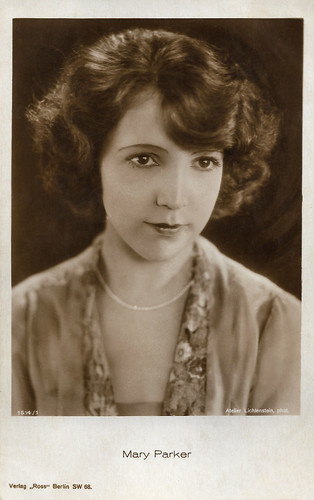
German postcard by Ross Verlag, Berlin, no. 1514/1, 1927-1928. Photo: Atelier Lichtenstein.
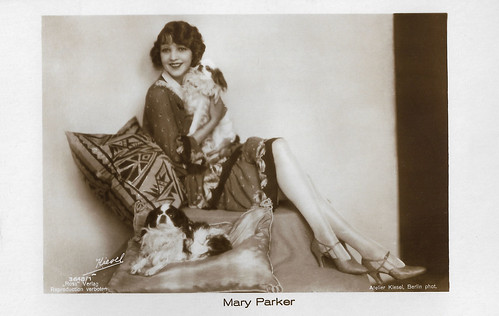
German postcard by Ross Verlag, Berlin, no. 3648/1, 1928-1929. Photo: Atelier Kiesel, Berlin.
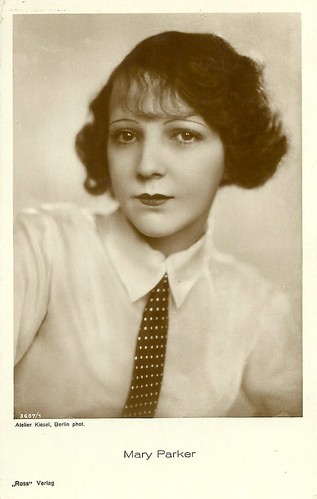
German postcard by Ross Verlag, Berlin, no. 3607/1, 1928-1929. Photo: Atelier Kiesel, Berlin.
Sources: Filmportal.de, Cyranos and IMDb.
No comments:
Post a Comment